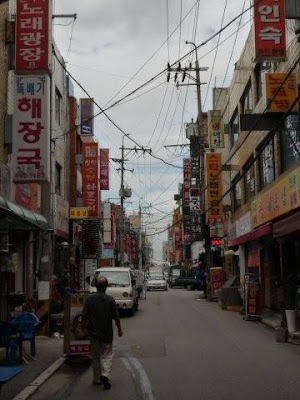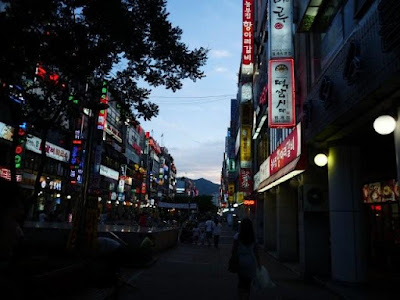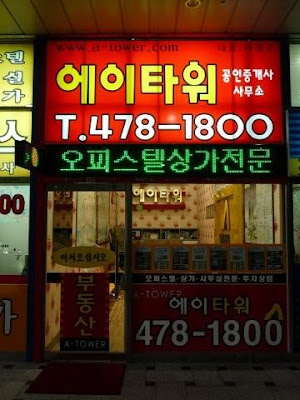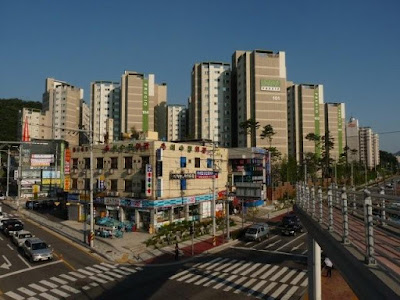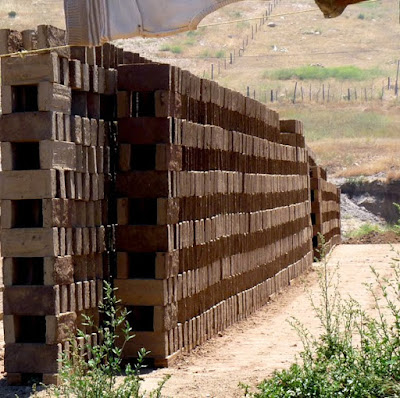Category: Uncategorized
Rene Peralta se ha caducado la ciudad globalizada en las artes? ya no le interesa a nadie la Tijuana posmoderna??? su clímax fue newsweek 2002 y nortec? se murio la revu e insite al mismo tiempo?? ya no somos globales ni glo-cal solo local? nuestro home made Matthai es el nuevo Canclini?? what do you guys think?
A Tijuana Calidad de Vida le gusta esto.





La Revu revive, después de Nortec: el ruidosón, mejor Matthai que Canclini (por mucho, eh). No necesitamos ser globales ni glocales, todo mundo es/ha devenido en TJ. Por eso, ahora mismo podemos ser lo que siempre fuimos: nosotros mismos.





Welcome to Post-TJ!

 Rene Peralta Mi estimado Rafa estoy escribiendo sobre este tema para nuestros amigos Josh y Fiamma! tarde pero seguro. pero si me gustaría elaborar bien el tema. tu me dices como esta la onda. y gracias
Rene Peralta Mi estimado Rafa estoy escribiendo sobre este tema para nuestros amigos Josh y Fiamma! tarde pero seguro. pero si me gustaría elaborar bien el tema. tu me dices como esta la onda. y gracias
El Blog del Curso; Tijuana Studio 2010 de Washington University que estoy impartiendo con John Hoal y Marcel Sánchez. aquí se publicaran imágenes, análisis y los proyectos finales.

Final Reviews / Presentaciones de Fin de Curso
We are preparing to complete the 2010 Tijuana summer studio for Washington University @ Woodbury San Diego. The studio focused on urban rivers and urban development in three major cities; Los Angeles and the LA River canal – Mexico City and the valley of Chalco and its open sewer canal – Tijuana and the TJ River canal. All students visited the three sites during the first part of the course and are now getting ready to present their final projects.
Our Final review takes place on Friday, July 02, 2010. We will begin at 11:00 am, break for lunch at 1pm (lunch included) and review until 6pm.
Reception after review 6pm-9pm
Objectives:
The VC_TJ_LA Fluvial Transect: Water
The objective of the 2010 Tijuana Studio is to investigate the relationships between three major cities and their urban rivers; Los Angeles and the LA River, Tijuana and Rio Tijuana and Mexico City and Valle de Chalco. These three urban areas have developed through excessive degradation of their natural environment due to population increases, rampant development and overall disregard by their respective state agencies of matters in sustainable planning and conservation. These three cities share a common history since the era of the Spanish Colonies in the New World yet their final political fate was decided after the US-Mexico war of 1848. These three cities can trace their urban history to their rivers since they were the major source of water for agriculture, human consumption and economic activity. Revisiting their history we can find the efforts of the first settlers to live in symbiosis with the river and their water sheds respecting the natural conditions of the flood plains. It’s not until the Spanish arrived and the industrialization of the cities, that rivers began their degradation and total abandonment, the fate of all three rivers was concrete channelization to control flooding of the haphazard urban development of the areas.
Today all three cities are redirecting efforts to revitalize the river fronts after many years of neglect or just simply abandonment. The city of Los Angeles in intending to remove the concrete channel in some areas of the LA River and implement a series of public spaces along its flow and restore native vegetation. The Tijuana River is now a part of a bi-national environmental debate between San Diego and Tijuana and efforts to control waste runoff from adjacent squatting settlements is a primary concern. The floods of the early 2010 in Mexico City made the canals along the urban areas to overflow endangering the lives of thousands of low income inhabitants in the community of Valle de Chalco. It is imperative to the future of the mentioned urban areas to redirect attention to their natural habitat, a place that is somewhat part of a shared history and an important element of local identity. This urban design summer studio will intend to locate the common threads between all of them and strategize punctual and local alternatives to the urbanized areas along the rivers with the inspiration of returning to a symbiotic existence between society and nature, and the potential for a sustainable urban future.
Plan De Cultura Para una Nueva Tijuana, cont.
Aquí dos ejemplos de como la cultura y el transporte publico pueden ir mano a mano. Estas intervenciones son de eventos artísticos en espacios diseñados para el transporte.
1 eventos culturales en las estaciones que son parte del circuito TransMilenio en Bogota, uno de los sistemas mas eficientes de transporte publico en el mundo.
http://www.transmilenio.gov.co/WebSiteGaleriaDeFotos/ViernesCultural/index.html
2. opera en la central camionera de Tijuana. Confundidos entre el publico artistas de opera de Tijuana vestidos de trabajadores de limpieza, maleteros, cajeras etc realizaron un espectáculo operístico para el asombro del publico/usuario de la central.
Se pudiese ir mas alla de solo presentar espectáculos/obras de arte, otra alternativa es diseñar las estaciones y centrales con espacios dedicados a la cultura, con la intención de acercar el quehacer cultural a las miles de personas que usan el transporte publico en la ciudad. Un solo presupuesto – dos infraestructuras!
Plan de Cultura para una Nueva Tijuana
Primero, los felicito por el gran esfuerzo que se hizo en elaborar esta novedosa iniciativa cultural para Tijuana, creo que es un momento sin precedente en la historia de la ciudad. Me gustaría presentarles mi apoyo por medio de algunas observaciones sobre el Plan de Cultura, ya que no podre asistir a la reunión de mañana por cuestiones laborales. De antemano me disculpo.
Después de revisar el documento publicado en el blog (plandeculturatijuana.blogspot.com/), me parece que la extensión de los ejes abarca gran parte de la sociedad vulnerable y marginada de esta ciudad. Es importante alinear los conceptos de derecho a la ciudad con propuestas culturales para la generación de comunidades sanas. La ciudad la hacemos todos y tenemos el derecho de imaginarla, vivirla juntos como sociedad. El derecho a la ciudad no solo implica ocuparla, si no también incluye el poder de transformarla.
Sin embargo la ciudad siempre ha sido un lugar de conflictos, y como reaccionamos a estos conflictos (de forma constructiva o destructiva) es la clave para lograr un balance social. Los deseos y derechos sobre la ciudad la tenemos todos (buenos y malos) y son estos conflictos que han generado, en las mejores ciudades, resultados positivos e inclusivos. Por ejemplo los problemas de los asentamientos irregulares en Latino América se han intentado erradicar usando la fuerza pública y en otras instancias se han reconocido como una forma diferente de habitar la ciudad, que requieren de una visión inclusiva de hacer ciudad y del ciudadano, renovando en si la definición establecida y vertical de sociedad. Esta nueva visión de la ciudad ocurre cuando se reforman las prácticas económicas y políticas que promueven las iniciativas públicas y controlan practicas de privatización de la ciudad.
El Plan de Cultura es un documento que nos despierta las ganas de renacer como ciudadanos e invita hacernos responsables de nuestra propia existencia social. Pero lo que me preocupa es la incompatibilidad que tiene con los poderes que en este momento estan formando la ciudad. Vivimos en una ciudad dominada por un sistema económico de libre mercado que opera dentro una jurisdicción de garantías individuales e independientes de intervenciones de estado. Este sistema garantiza el derecho individual de hacer con nuestros bienes lo que nos convenga dentro de un sistema de mercado libre. Por ejemplo el estado (municipalidad) ha tenido muy poco poder en controlar el tipo y calidad de vivienda de los desarrolladores privados en la ciudad. Estas empresas, que controlan grandes áreas de terreno en la ciudad (como Valle de Las Palmas), les interesa manejar los desarrollos de vivienda como simple inversiones económicas y son más endebles a cambios en la bolsa de valores que en restricciones por leyes o planes maestros del municipio. En Tijuana los dueños de la tierra controlan la ciudad. Cómo hacer para que estas propuestas culturales aterricen de manera exitosa dentro de una dinámica económica de privatización. Aunque la propuesta no es partidaria, como dice la invitación al evento de mañana, si es política y necesita de una visión radical que tenga en su raíz la generación del espacio público en toda la extensión de la ciudad. Una política que esté interesada en crear una ciudad equitativa y accesible para todos. Es tiempo que el derecho a la ciudad no solo sea para aquellos que la pueden comprar o son dueños de extensiones territoriales. El derecho a la ciudad y sus espacios sociales deben de estar por encima de los intereses de grupos de poder que en estos momentos siguen formando la ciudad desde afuera.
Como implementara el nuevo alcalde este Plan de Cultura en términos geográficos, como se liberaran zonas para realizar nuevos espacios sociales? O quizás estas propuestas deberían dirigirse a la iniciativa privada junto con un análisis económico. Podría la cultura ser redituable económicamente??
Pienso que cualquier candidato que se presente a esta reunión debe de dejar claro como se generaran los espacios para los nuevos centros culturales/comunitarios que se están proponiendo, como se le exige a los terratenientes y desarrolladores de la ciudad que integren el Plan de Cultura en sus proyectos. Obligación más allá del 10% de tierra que se les requiere donar a la ciudad para este tipo de espacios. Tierra que en la mayoría de los casos no tiene las características adecuadas para la construcción de parques o escuelas o de plano al ser donado al municipio este lo a vender al mejor postor para volverse a urbanizar. En cada caso lo importante es generar una política social que promueva el bienestar social y la oportunidad de crear e imaginar la ciudad a todos los ciudadanos. Este plan es muy provocativo por que inicia de un proceso local ( bottom up) sin embargo necesita llegar a unirse con una visión política de ciudad (top-down) que tenga la fuerza para crear zonas y espacios públicos sin condicionantes de los grupos de poder.
Transporte y Cultura
El tercer punto del primer eje en el Plan de Cultura vincula la cultura con el transporte público y es de gran importancia para la inmediata activación de la propuesta. La responsabilidad del estado es generar un sistema de transporte digno y eficiente para los ciudadanos. Actualmente el transporte público de la ciudad es de mayor costo (por salario) que el de la ciudad vecina de San Diego, que tiene mayor extensión territorial que Tijuana. El transporte público sigue controlado por grupos hegemónicos que han podido combatir intentos de reestructuración del sistema por alcaldes de administraciones anteriores. Se han elaborado cantidad de proyectos de sistemas de transporte público (tren ligero, metro-bus etc.) que no se han podido realizar por la falta de convicción política. El tema vuelve a la mesa en estas elecciones del 2010 y se está presentando de nuevo un plan de reestructuración de rutas así como un modelo de metro-bus que dará servicio desde la garita internacional de San Ysidro hacia la comunidad del Florido al este de la ciudad. Este sistema brindaría un servicio más eficiente y digno a los ciudadanos de Tijuana y aliviara el tráfico vehicular de sus avenidas principales. Este sistema brindaría beneficios económicos a la cuidad, ya que se recortaría el tiempo y costo de traslado de la clase trabajadora y facilita los viajes de productos dentro y fuera de la ciudad. La propuesta tendrá varios procesos de elaboración y es probable que sea la más importante de la próxima administración. Por lo tanto creo que tres años no son suficientes para construir todo el sistema y necesitaría de coordinación entre administraciones. Si este es el único proyecto al que se compromete de lleno el próximo alcalde nos haria muy bien.
Y si ese fuera el caso, el estado se compromete a solucionar el problema del transporte público y se dedica a realizar esta obra, como podríamos seguir insistiendo que se realice el Plan de Cultura. El transporte público se puede pensar junto con otras actividades y realizarse como un espacio multi-funcional de programas públicos. Si las estaciones se planean de manera adecuada podrán activar zonas de comercio y establecer una relación física con centros comunitarios. Las estaciones de transporte público (metro-bus o tren ligero) pueden ser el hilo que teje y comunica a la ciudad. La función de una estación de transporte puede ser híbrida y funcionar como espacio cultural, publico y comercial. Cada estación tiene la oportunidad de convertirse en un centro importante que regenere colonias y delegaciones formando parte de una nueva identidad comunitaria. Es importante que los dos proyectos (transporte y cultura) se vinculen para así poder unir presupuestos y proyectos en el corto tiempo de la nueva administración. De esta manera con la hibridación de las funciones el Programa Cultural no tendrá que sufrir recortes de presupuesto o desvió de fondos que se utilizaron para otros proyectos que podrían verse más urgente. Las visiones mono-funcionales nos son prácticas, tenemos que pensar cómo integrar funciones (infraestructura y cultura) y presupuestos de forma híbrida, como bien lo dice el Plan “El transporte público, pues, será uno de los vehículos clave de transmisión de la nueva cultura de paz, legalidad y concordia en la ciudad.”
Gracias y Felicidades
René Peralta
Viernes 25 de Junio – 6pm.
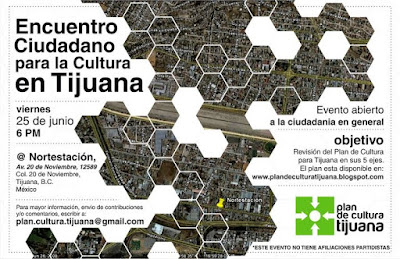
Mas Info Aquí: http://www.plandeculturatijuana.blogspot.com/
Estos últimos meses he tenido la suerte de ver y estudiar otras ciudades y charlar con gente muy apasionada por el urbanismo. Terminando dos cursos que estoy impartiendo ( Taller de diseño urbano de Washington University y seminario de urbanismo latinoamericano en SciArc) voy a postear algunas ideas.
R.



